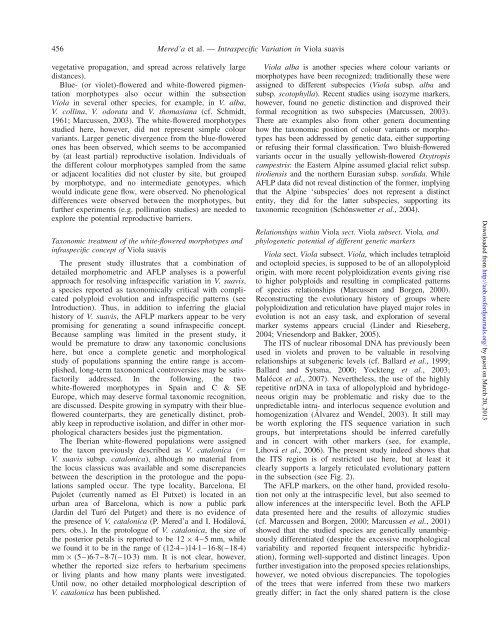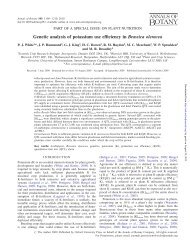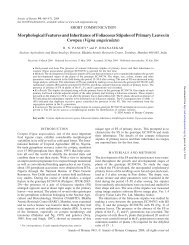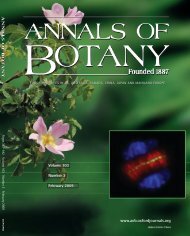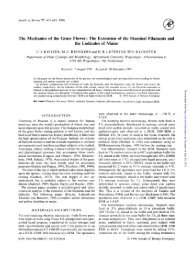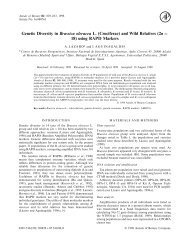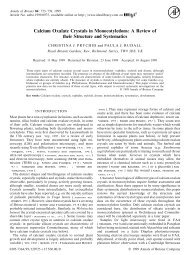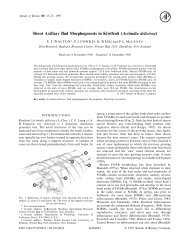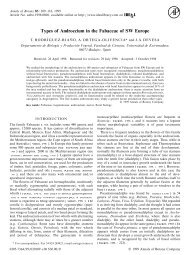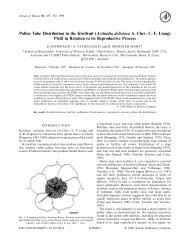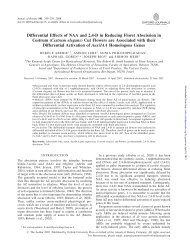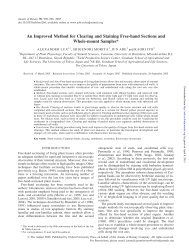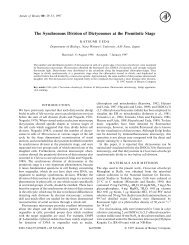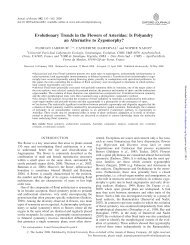Intraspecific Variation in Viola suavis in Europe ... - Annals of Botany
Intraspecific Variation in Viola suavis in Europe ... - Annals of Botany
Intraspecific Variation in Viola suavis in Europe ... - Annals of Botany
Create successful ePaper yourself
Turn your PDF publications into a flip-book with our unique Google optimized e-Paper software.
456<br />
vegetative propagation, and spread across relatively large<br />
distances).<br />
Blue- (or violet)-flowered and white-flowered pigmentation<br />
morphotypes also occur with<strong>in</strong> the subsection<br />
<strong>Viola</strong> <strong>in</strong> several other species, for example, <strong>in</strong> V. alba,<br />
V. coll<strong>in</strong>a, V. odorata and V. thomasiana (cf. Schmidt,<br />
1961; Marcussen, 2003). The white-flowered morphotypes<br />
studied here, however, did not represent simple colour<br />
variants. Larger genetic divergence from the blue-flowered<br />
ones has been observed, which seems to be accompanied<br />
by (at least partial) reproductive isolation. Individuals <strong>of</strong><br />
the different colour morphotypes sampled from the same<br />
or adjacent localities did not cluster by site, but grouped<br />
by morphotype, and no <strong>in</strong>termediate genotypes, which<br />
would <strong>in</strong>dicate gene flow, were observed. No phenological<br />
differences were observed between the morphotypes, but<br />
further experiments (e.g. poll<strong>in</strong>ation studies) are needed to<br />
explore the potential reproductive barriers.<br />
Taxonomic treatment <strong>of</strong> the white-flowered morphotypes and<br />
<strong>in</strong>fraspecific concept <strong>of</strong> <strong>Viola</strong> <strong>suavis</strong><br />
The present study illustrates that a comb<strong>in</strong>ation <strong>of</strong><br />
detailed morphometric and AFLP analyses is a powerful<br />
approach for resolv<strong>in</strong>g <strong>in</strong>fraspecific variation <strong>in</strong> V. <strong>suavis</strong>,<br />
a species reported as taxonomically critical with complicated<br />
polyploid evolution and <strong>in</strong>fraspecific patterns (see<br />
Introduction). Thus, <strong>in</strong> addition to <strong>in</strong>ferr<strong>in</strong>g the glacial<br />
history <strong>of</strong> V. <strong>suavis</strong>, the AFLP markers appear to be very<br />
promis<strong>in</strong>g for generat<strong>in</strong>g a sound <strong>in</strong>fraspecific concept.<br />
Because sampl<strong>in</strong>g was limited <strong>in</strong> the present study, it<br />
would be premature to draw any taxonomic conclusions<br />
here, but once a complete genetic and morphological<br />
study <strong>of</strong> populations spann<strong>in</strong>g the entire range is accomplished,<br />
long-term taxonomical controversies may be satisfactorily<br />
addressed. In the follow<strong>in</strong>g, the two<br />
white-flowered morphotypes <strong>in</strong> Spa<strong>in</strong> and C & SE<br />
<strong>Europe</strong>, which may deserve formal taxonomic recognition,<br />
are discussed. Despite grow<strong>in</strong>g <strong>in</strong> sympatry with their blueflowered<br />
counterparts, they are genetically dist<strong>in</strong>ct, probably<br />
keep <strong>in</strong> reproductive isolation, and differ <strong>in</strong> other morphological<br />
characters besides just the pigmentation.<br />
The Iberian white-flowered populations were assigned<br />
to the taxon previously described as V. catalonica (¼<br />
V. <strong>suavis</strong> subsp. catalonica), although no material from<br />
the locus classicus was available and some discrepancies<br />
between the description <strong>in</strong> the protologue and the populations<br />
sampled occur. The type locality, Barcelona, El<br />
Pujolet (currently named as El Putxet) is located <strong>in</strong> an<br />
urban area <strong>of</strong> Barcelona, which is now a public park<br />
(Jard<strong>in</strong> del Turó del Putget) and there is no evidence <strong>of</strong><br />
the presence <strong>of</strong> V. catalonica (P. Mered’a and I. Hodálová,<br />
pers. obs.). In the protologue <strong>of</strong> V. catalonica, the size <strong>of</strong><br />
the posterior petals is reported to be 12 4–5 mm, while<br />
wefoundittobe<strong>in</strong>therange<strong>of</strong>(12.4–)14.1–16.8(–18.4)<br />
mm (5–)6.7–8.7(–10.3) mm. It is not clear, however,<br />
whether the reported size refers to herbarium specimens<br />
or liv<strong>in</strong>g plants and how many plants were <strong>in</strong>vestigated.<br />
Until now, no other detailed morphological description <strong>of</strong><br />
V. catalonica has been published.<br />
Mered’a et al. — <strong>Intraspecific</strong> <strong>Variation</strong> <strong>in</strong> <strong>Viola</strong> <strong>suavis</strong><br />
<strong>Viola</strong> alba is another species where colour variants or<br />
morphotypes have been recognized; traditionally these were<br />
assigned to different subspecies (<strong>Viola</strong> subsp. alba and<br />
subsp. scotophylla). Recent studies us<strong>in</strong>g isozyme markers,<br />
however, found no genetic dist<strong>in</strong>ction and disproved their<br />
formal recognition as two subspecies (Marcussen, 2003).<br />
There are examples also from other genera document<strong>in</strong>g<br />
how the taxonomic position <strong>of</strong> colour variants or morphotypes<br />
has been addressed by genetic data, either support<strong>in</strong>g<br />
or refus<strong>in</strong>g their formal classification. Two bluish-flowered<br />
variants occur <strong>in</strong> the usually yellowish-flowered Oxytropis<br />
campestris: the Eastern Alp<strong>in</strong>e assumed glacial relict subsp.<br />
tiroliensis and the northern Eurasian subsp. sordida. While<br />
AFLP data did not reveal dist<strong>in</strong>ction <strong>of</strong> the former, imply<strong>in</strong>g<br />
that the Alp<strong>in</strong>e ‘subspecies’ does not represent a dist<strong>in</strong>ct<br />
entity, they did for the latter subspecies, support<strong>in</strong>g its<br />
taxonomic recognition (Schönswetter et al., 2004).<br />
Relationships with<strong>in</strong> <strong>Viola</strong> sect. <strong>Viola</strong> subsect. <strong>Viola</strong>, and<br />
phylogenetic potential <strong>of</strong> different genetic markers<br />
<strong>Viola</strong> sect. <strong>Viola</strong> subsect. <strong>Viola</strong>, which <strong>in</strong>cludes tetraploid<br />
and octoploid species, is supposed to be <strong>of</strong> an allopolyploid<br />
orig<strong>in</strong>, with more recent polyploidization events giv<strong>in</strong>g rise<br />
to higher polyploids and result<strong>in</strong>g <strong>in</strong> complicated patterns<br />
<strong>of</strong> species relationships (Marcussen and Borgen, 2000).<br />
Reconstruct<strong>in</strong>g the evolutionary history <strong>of</strong> groups where<br />
polyploidization and reticulation have played major roles <strong>in</strong><br />
evolution is not an easy task, and exploration <strong>of</strong> several<br />
marker systems appears crucial (L<strong>in</strong>der and Rieseberg,<br />
2004; Vriesendorp and Bakker, 2005).<br />
The ITS <strong>of</strong> nuclear ribosomal DNA has previously been<br />
used <strong>in</strong> violets and proven to be valuable <strong>in</strong> resolv<strong>in</strong>g<br />
relationships at subgeneric levels (cf. Ballard et al., 1999;<br />
Ballard and Sytsma, 2000; Yockteng et al., 2003;<br />
Malécot et al., 2007). Nevertheless, the use <strong>of</strong> the highly<br />
repetitive nrDNA <strong>in</strong> taxa <strong>of</strong> allopolyploid and hybridogeneous<br />
orig<strong>in</strong> may be problematic and risky due to the<br />
unpredictable <strong>in</strong>tra- and <strong>in</strong>terlocus sequence evolution and<br />
homogenization (Álvarez and Wendel, 2003). It still may<br />
be worth explor<strong>in</strong>g the ITS sequence variation <strong>in</strong> such<br />
groups, but <strong>in</strong>terpretations should be <strong>in</strong>ferred carefully<br />
and <strong>in</strong> concert with other markers (see, for example,<br />
Lihová et al., 2006). The present study <strong>in</strong>deed shows that<br />
the ITS region is <strong>of</strong> restricted use here, but at least it<br />
clearly supports a largely reticulated evolutionary pattern<br />
<strong>in</strong> the subsection (see Fig. 2).<br />
The AFLP markers, on the other hand, provided resolution<br />
not only at the <strong>in</strong>traspecific level, but also seemed to<br />
allow <strong>in</strong>ferences at the <strong>in</strong>terspecific level. Both the AFLP<br />
data presented here and the results <strong>of</strong> allozymic studies<br />
(cf. Marcussen and Borgen, 2000; Marcussen et al., 2001)<br />
showed that the studied species are genetically unambiguously<br />
differentiated (despite the excessive morphological<br />
variability and reported frequent <strong>in</strong>terspecific hybridization),<br />
form<strong>in</strong>g well-supported and dist<strong>in</strong>ct l<strong>in</strong>eages. Upon<br />
further <strong>in</strong>vestigation <strong>in</strong>to the proposed species relationships,<br />
however, we noted obvious discrepancies. The topologies<br />
<strong>of</strong> the trees that were <strong>in</strong>ferred from these two markers<br />
greatly differ; <strong>in</strong> fact the only shared pattern is the close<br />
Downloaded from<br />
http://aob.oxfordjournals.org/ by guest on March 20, 2013


